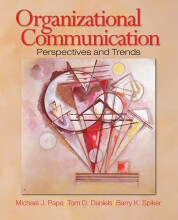Summary: Organizational Communication Perspectives And Trends | 9781412916844 | Michael J Papa, et al
- This + 400k other summaries
- A unique study and practice tool
- Never study anything twice again
- Get the grades you hope for
- 100% sure, 100% understanding
Read the summary and the most important questions on Organizational Communication Perspectives and Trends | 9781412916844 | Michael J. Papa; Tom D. Daniels; Barry K. Spiker
-
1 Orientation to, OC
This is a preview. There are 1 more flashcards available for chapter 1
Show more cards here -
How does the traditional perspective view organisations?
As objects that can be objectively observed and is concerned with communication processes and organisational effectiveness -
How does the early version of the traditional perspective define organisations?
- Treats organisations as machines, an engineered set of interconnected parts that operate by managerial control
- Depends on well-maintained communication in order to function efficiently and effectively
- Managers control the machine by gaining compliance & cooperation from employees= control & coordination
- Control & coordination depend on effective communication
- Organisations as political entities; power resides with those who have access to resources -> management is in control
-
How does the later view of the traditional perspective view organisations?
- Organisations as organisms or living systems
- More complex entity than machine, with many subsystems of control and self-regulation
- Adaptable to change, responsive to the environment, flexible
- Broader objectives, not just productivity but also employee welfare, quality of life and sense of belonging
-
How does the interpretive perspective define organisations?
- Organisations as cultures
- Organisational reality is socially constructed through communication= network of shared meanings
- Investigates negotiated order = how members understand their experiences through communication and enact the organisation based on shared meanings
-
How does the critical view perceive organisations?
- Organisations as instruments of privilege and or oppression
- Dominant elite, political interest. With acces to resources
- Structural, communicative barriers for the disadvantaged
- Oppression created and reinforced through language and discourse and through inherent power differences in the organisational systems
-
2 Communication and its funtions
This is a preview. There are 11 more flashcards available for chapter 2
Show more cards here -
With what does strategic ambiguity help?
- to promote cohesion by highlighting members' agreement on abstract, general ideas and by obscuring their disagreements over specific details
- to adapt more readily to change
- means for supporting status distinctions and maintaining interpersonal relationships in organisations
-
What is nonverbal behaviour (three forms)?
- paralanguage: nonverbal speech sounds, intonation. regulates spoken expressions
- body movement: emblems, illustrators, regulators, affect displays, adaptors.
- space: boundaries of space
-
Which three functions does communication display according to Dance & Larson?
- linking: communication used to establish relationships between the individual and the environment (symbols)
- mentation: communication stimulates the development on hgiher order mental processes and leads to mental growth, culture is shaped and reflected by the language its members speak
- regulatory: the basis for the refinement and extension to humans of the host of methods of behaviour regulation that operate upon all living organisms
-
Three functions of social capital (features of social organisation, e.g. trust, norms, and networks that can improve the efficiency of society by facilitating coordinated actions)
- source of control
- source of group support
- source of benefits through interlinked group networks
-
What does symbolic interactionism entail?
- reality is created by people
- knowledge of the world is based on what has been shown to be useful
- define physical and social objects according to their use
- understanding of actors is based on what they do in the world
- social world is an ongoing creation that changes and evolves as people act toward one another
- the self is reflexive, seen as both the actor and subject
- the generalised other= the collective attitudes of an entire group, community or society
- Higher grades + faster learning
- Never study anything twice
- 100% sure, 100% understanding
































